
Belief in Hinduism and other folklore has an incredible capacity to protect biodiversity in India, where devotees possibly protect 125,000 sacred forest groves containing hundreds of species.
Sacred groves in India are patches of land that are communally protected with religious zeal, that at the same time tend to be relic forest segments. Inside, traditions often lead to the protection even of animals that the broader civilization would find undesirable, like snakes.
Preserved, and mostly associated with temples, sacred groves are culturally important to the people of India, but also harbor incredibly dense amounts of biodiversity.
A landmark paper published in 2017 used a case study of two sacred groves in the western Himalayas to extrapolate their influence on biodiversity in the country.
Hariyali Devi is located above Kodima village at an altitude of 4,200 feet (1,400 meters) in Rudraprayag, in the high northern Indian state of Uttarakhand. Inside the temple contains a bejeweled idol of Ma Hariyali Devi astride a lion, and is an important center of local festivities.
Within this relatively small space were 80 species of plants, 12 kinds of mammals, 9 species of birds, and 7 species of butterflies. The neighboring Tungnath sacred grove even included black bears.
Other studies have confirmed the incredibly rich biodiversity in sacred groves and their tree species, according to a 2018 study. There were 144 tree species recorded in sacred groves in the central-western Ghats, compared with 91 species counted in rural forests in the region.

“It’s something which is ingrained into every Hindu worshipper: temples, trees and ponds are all meant to be a collective space of worship,” Lakshman Acharya, a priestess in Pallalamma temple in Andhra Pradesh, southern India, told the BBC.
All manner of institutions are beginning to recognize the value of these groves to the natural heritage of the country, as well as to the country’s ambitious reforestation goals.
The Applied Environmental Research Foundation (AERF) has helped restore 80 of these sacred groves across the western Ghats mountain range while simultaneously helping locals switch from destructive logging to cultivation of commercially-important fruit species that happen to be the favorite haunts for endangered hornbills and tree pangolins.
The Devrai Foundation, an environmental non-profit in Pune in western India, is involved in building man-made sacred forests, known as devrais. To date they have preserved 119 species of plants, including the giant crape myrtle and Indian coral tree, also called pangara or flame of the forest.
While they can’t support India’s biodiversity on their own, their existence is both romantic and practical for the policy maker looking to try and protect the country’s wild places.
Share This Hindu News With Your Friends On Social Media…




















